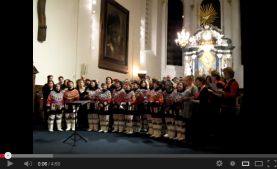In 1721, the Norwegian missionary Hans Egede arrived at the west coast of Greenland close to what is today the country’s capital Nuuk. Frederik IV, king of Denmark-Norway, had given him permission to set up a mission in Greenland (Fægteborg 2009: 42), and with this mission a protestant hymn tradition was introduced in Greenland (Lynge 1981: 24). In 1733, a small group of Moravians was sent to Greenland to support Hans Egede’s mission. But the Moravian mission took the form of a competing mission instead of a supporting one, and had a significant impact on the course of history in Greenland in the centuries that followed. The Moravians differentiated themselves from the mission of Hans Egede and his family, by displaying a more emotional relationship to their religion and placing a high emphasis on the use of music when preaching. Their mission remained in Greenland until the year 1900, at which time they, following a decrease in the size of their congregation, left Greenland (Wilhjelm 2000: 203, 206, 209).
Some of the hymns sung in Greenland today are translations of European hymns, but from the mid-19th century Greenlandic composers, starting with Rasmus Berthelsen (1827-1901), have contributed to the hymn and song repertoire. These hymns and songs can be found in Erinarsuutit (‘The song book’) which was first published in 1908 (Langgård 2011: 124). Choir singing in Greenland has become an important element in Greenlandic national culture. Many towns have one or more choirs that perform at special occasions and often release recordings of their repertoire of hymns and romantic national songs (Johansen 1991: 48). In Denmark, where a significant number of Greenlanders live either permanently or while getting a post-secondary education, several Greenlandic choirs function as a leisure activity and an affirmation of Greenlandic identity.
Even though hymn and choir singing in Greenland emerged from a mix of Dano-Norwegian and Moravian mission work, there are traits in the style that cannot be easily traced back to European styles. One such is the use of the wording ‘aja’ in some of these hymns and choir songs, a wording that has no particular meaning but is known from pre-colonial song style (Larsen 1997: 63). The Greenlandic choir tradition also has a very distinct musical sound. A kind of ‘spontaneous’ polyphony has evolved based on the four voice harmonies of the organ accompanying the hymns at churches, so that all hymns during a service were often sung in polyphony by the congregation. This polyphony along with a preference for slow tempi have been noted by others to be some of the characteristics of the sound of Greenlandic choir singing (Johansen 1991: 48; Larsen 1997: 60), but I suggest that a tolerance for a wide range of intonation is another characteristic of this valued and beloved musical style. Heavy use of glissando is also a feature that to my ears distinguishes Greenlandic choir singing from its European counterparts, and this idiom has been noted as one of the characteristics of singing in the frame drum style (cf. Johansen 1991: 40).
Fig. 3: The choir Aavaat performing the Christmas hymn “Guuterput qutsinnermiu” (‘Our Lord in the highest’) composed by Rasmus Berthelsens.

